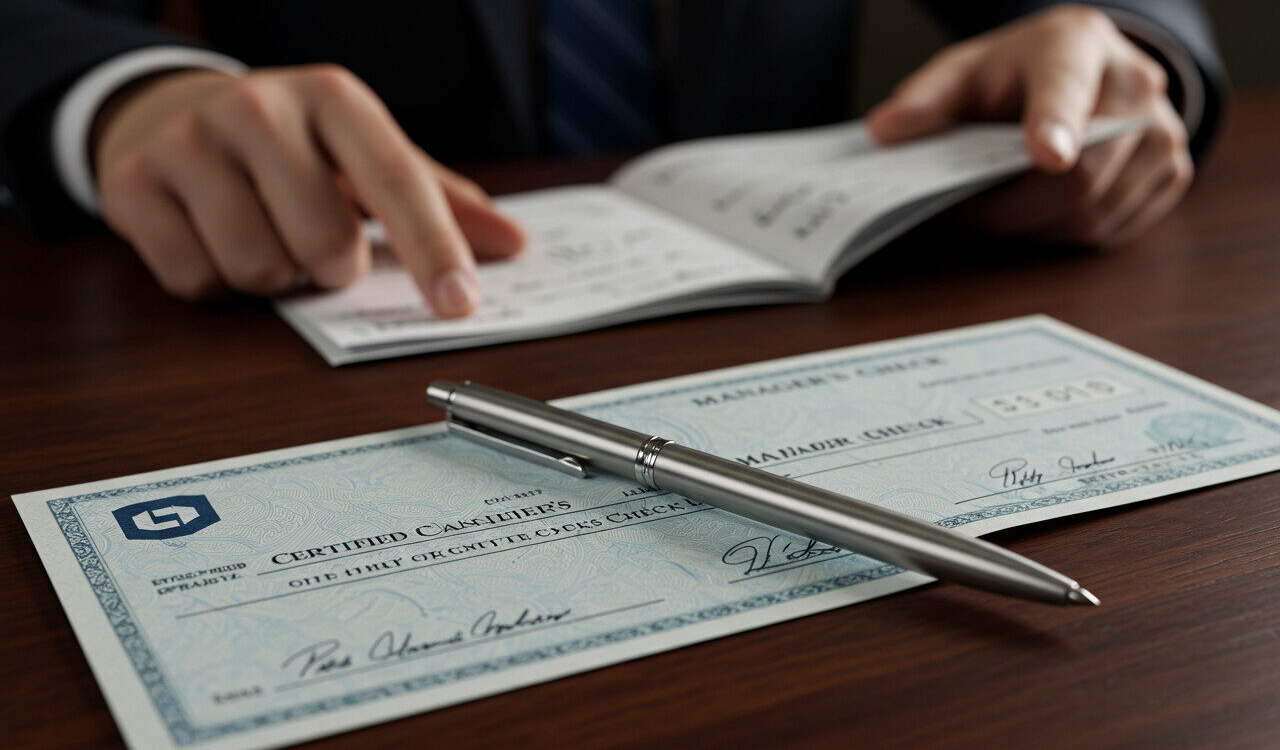Major Highlights
- See how each kind of cashier’s check and manager’s check helps keep payments safe.
- Find out how to get these official checks and what benefits come with using them.
- Learn when each check is best for large payments to ensure transactions are secure.
- Follow simple steps to get a cashier’s or manager’s check at banks or credit unions.
- Get answers on fraud prevention, payment limits, and how to stop payments if needed.
- Compare what each check offers to choose the best option for specific needs.
Introduction
Moving around in the world of money can feel hard, especially when large sums must be sent. When handling significant amounts, cashier’s checks and manager’s checks might work better than regular checks or cash. These checks are issued by financial institutions and use their funds instead of just the account holder’s, offering greater security. They are commonly used in real estate transactions or business dealings to ensure payments are guaranteed.
Cashier’s Checks and Manager’s Checks Explained
Cashier’s checks and manager’s checks are two special types of official bank checks, different from personal checks. A cashier’s check draws directly from a bank’s own reserves. A manager’s check uses client funds managed by the bank. Both provide strong payment guarantees and are useful for large payments where security is critical.
What Is a Cashier’s Check
A cashier’s check is a secure payment method issued by a bank or credit union using its own funds. It provides a guarantee that the payee will receive the full amount, making it ideal for major purchases like real estate or vehicles. Security features such as watermarks and authorized signatures help prevent fraud. Receipts must be kept for proof in case of loss.
What Is a Manager’s Check
A manager’s check functions similarly but uses the customer’s funds held by the bank. It is often used in business transactions and for payments requiring trusted delivery. Security features include special stamps and unique numbers to prevent counterfeiting.
Main Differences Between the Checks
Cashier’s checks are funded by the bank’s reserves, while manager’s checks draw from the client’s account or bank-managed funds. Cashier’s checks are generally viewed as more secure for very large transactions. Fees vary by bank and check type, so it is recommended to confirm costs in advance.
Issuing Authority and Process
| Feature | Cashier’s Check | Manager’s Check |
|---|---|---|
| Source of Funds | Bank’s reserves | Client’s funds managed by bank |
| Issuing Authority | Financial institution | Financial institution |
| Common Usage | Large purchases (homes, cars) | Business transactions |
| Fees | Generally higher | Generally lower |
| Security Features | Watermarks, signatures | Stamps, unique identifiers |
Both checks are processed with assistance from bank staff to ensure accuracy.
Security Features and Fraud Protection
- Watermarks and Signatures: Ensure authenticity.
- Stamped Details: Bank name and payee information are printed clearly.
- Receipts: Retain for proof and tracking.
Always verify checks with the issuing bank to avoid counterfeit risks. Report suspicious activity promptly.
When to Use Each Check
Use cashier’s or manager’s checks for large, guaranteed payments such as buying a car or house, paying deposits, or making secure business payments. Select the check type based on the amount, purpose, and the payee’s preference.
Common Uses for Cashier’s Checks
- Real estate transactions
- Vehicle purchases
- Legal settlements
- Renovations and improvements
These payments often need quick clearance and reliable funds.
Common Uses for Manager’s Checks
- Supplier payments
- Business agreements
- Large nonprofit donations
- International payments
Businesses often choose manager’s checks for trusted transactions.
How to Get a Cashier’s or Manager’s Check
To obtain either check, visit a bank or credit union with the following:
- Valid government-issued ID
- Bank account information or cash to fund the check
- Payee’s full name and payment amount
- Supporting documents, if applicable
Requests can be made in person or online, following bank procedures.
Steps to Get a Check
- Identify Payment Needs: Determine the amount and context to choose the appropriate check.
- Gather Identification and Details: Bring ID, account information, and payee details.
- Visit Bank or Credit Union: Go to a branch or use online services if available.
- Complete Forms and Pay Fees: Fill out required paperwork, pay any fees, and keep the receipt.
Final Thoughts
Cashier’s and manager’s checks offer secure ways to make large payments with bank-backed guarantees. They differ in funding sources and typical uses but share strong security measures. Choose the best option based on transaction size and purpose, and always verify fees and details with the bank for a smooth payment process.
FAQs
Is a manager’s check safer than a cashier’s check?
Both are secure with anti-fraud features. Cashier’s checks may offer slightly more security due to bank-issued funds.
How long do these checks take to clear?
Typically within one business day, depending on the bank.
Can a cashier’s or manager’s check be cancelled?
It is difficult but possible. Contact the bank immediately if lost or stolen to start the cancellation process.
Are there amount limits for these checks?
Most banks do not limit the amount if sufficient funds are available.
Updated by Albert Fang
Source Citation References:
+ Inspo
There are no additional citations or references to note for this article at this time.
